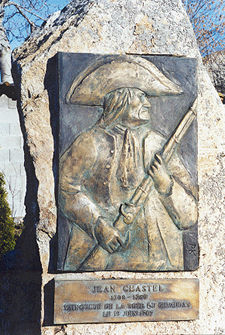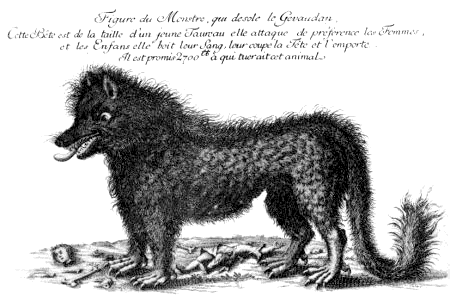Ah, France. The lush pastures; the fluffy, drifting clouds; the high-pitched whinny of a calf-sized monster as it rips out your throat in broad daylight. 18th-century France had many worries, but when something in the remote hills of Gévaudan (modern-day Lozère) attacked 240 people and killed 112,* one threat loomed above the many: La Bête du Gévaudan.
By all accounts, the beast first attacked in the early summer of 1764. A young woman tending cattle in the Mercoire forest found herself suddenly face-to-face with something like a hyena, if a hyena was big enough to stand level with one’s chest. She escaped with her life only because some of the bulls in her herd charged the creature and kept it at bay. The beast wouldn’t be slowed for long: 14-year-old Janne Boulet became its first victim on June 30, followed by two young girls on August 6th and August 8th, and a 15-year-old cowherd on August 30th. From there, things would only get worse.
This creature did not behave like your average predator. The villagers were used to wolves, which, while frightening, at least were killing for survival. Not so for la Bête, which often focused on its victims’ heads and would leave them only partially eaten, if at all. Also, it attacked women and children almost exclusively, and did not seem to have any interest in livestock or goats. Nor did it resemble anything the villagers had seen before, as evidenced from this oft-cited description:
These unusual characteristics led many to believe there was something supernatural about the creature, and fueled a lot of hysteria. As more and more bodies were found–some beheaded, some in an alarming state of undress–local and then national governments began to organize hunting parties with the hope of tracking and stopping the beast. The first large-scale party set off on September 15, 1764, comprised of 57 dragoons who would comb the hills and shoot at wolves, but fail to stop the attacks. As the search continued with no success, officials decriminalized the use of firearms for commoners, and offered more than 10,000 pounds for anyone who could kill the beast.
None of it did any good. On October 8th, two hunters came within ten paces of the creature and shot it twice. It fell, then got up and loped away. This wouldn’t be the last time the beast would seem impervious to gunfire, and it only made the panic worse. On December 31st, the bishop of Mende declared the creature was God’s retribution for Gévaudan’s sins. By then, 27 people had been attacked. 18 were dead.
King Louis XV, struggling to maintain the illusion of control, sent world-renowned wolf hunter Jean-Charles D’Evennel into the fray. On April 21, 1765, 10,000 men joined him in combing the hillsides, but–and you’ll notice the pattern here–they had no success. D’Evennel was eventually ordered away, to be replaced by a Mr. Antoine, the king’s personal arquebusier. Antoine threw himself at the task full-force, and on September 21, 1765, shot and killed a 130 pound wolf–the biggest ever on record. The people rejoiced, and the wolf was stuffed and wheeled around in the king’s court on October 1st. Louis chuckled at how the superstitious commoners had made an ordinary wolf into such a monster. Still, he, like everyone else, was just glad it was all over.
To date, 158 people had been attacked. 71 were dead. Gévaudan remained quiet a few weeks. Then, in December, the attacks started again.

Courtesy of Wikimedia Commons.
This time, the crown wanted nothing to do with it. It had declared the problem solved, and wouldn’t admit to error. The people of Gévaudan were on their own. Over 1766, the villagers continued to pray and hunters continued to hunt, but 36 more people were attacked, with 18 going to their graves. This was nothing compared to the carnage of the spring of 1767, though, which saw another 38 attacks and 21 deaths between January and June alone. The nineteen-year-old Marquis of Apcher rallied the people yet again to go into the woods. It would be the last time.

Courtesy of Wikimedia Commons.
On June 17, 1767, Jeanne Bastide–also nineteen–became the beast’s final victim, found with her throat torn apart. Two days later, during one of the hunts, farmer and innkeeper Jean Chastel came upon the creature, looked it in the eye, and shot it dead. Word has it that he’d forged silver bullets for the job, and had them blessed before going into the woods.
Thus on June 19, 1767, after three years of terror and almost 240 attacks, Gévaudan’s nightmare ended at last. But there were still a few peculiarities that were never solved.
First was the identity of the beast. It was said that the thing Chastel shot was more monster than wolf, but by the time he brought it to king, the carcass had decomposed so badly that Louis had it thrown out. No one knows where they buried it, and the remains have yet to be recovered, so historians have been unable to confirm what exactly the thing was. Based on the descriptions, the closest known analogy is the mesonychid–something like a carnivorous moose–but those were supposed to have gone extinct some 23 million years ago. It could have been a hyena or a lion–or perhaps some kind of hellish hybrid–but those would have to travel pretty far to get to France, wouldn’t they?
Unless, of course, someone brought them there. Oddly enough, it was rumored that Jean Chastel’s son had a few hyenas in his menagerie, as well as a giant red mastiff that bore some familial resemblance to the beast. The Chastels were also apparently at odds with arquebusier Antoine, and were actually thrown in prison for the duration of his stay in Gévaudan–a term which happened to coincide with a decrease in attacks. A few people did report seeing a man in conjunction with the beast, and it is odd that the attacks were so specific, almost as if the beast had been trained.
How did Chastel–a common innkeeper–manage to so effectively shoot and kill the creature, where hundreds of other, highly trained men could not?
No matter. The town erected a plaque in his honor, and he is remembered to this day as the hero that saved Gévaudan from from the 3 year-long nightmare of la Bête.

Chastel, courtesy of Wikimedia Commons and Χρήστης:Βήσσμα.
Here’s to hoping it stays dead this time.
Do you have any meddlesome pets that have got you in a bit of trouble? Feel free to share in the comments below!
*Numbers are approximate, and vary depending on the source. For the purpose of this post, I worked off the most detailed one I could find, located here.
Featured image by mana5280.


 “
“


0 Comments